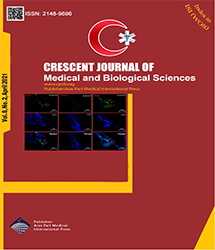
| Brief Report | |
| New Concepts for the Management of Atherosclerosis From Persian Medicine | |
| Rahim Firouzi1, Majid Asghari1, Fatimah Nojavan1, Fatimah Aliasl1, Arman Zargaran2, Abolfazl Mohammadbeigi3, Hossein Moradi1 | |
| 1Qom University of Medical Sciences, Faculty of Persian Medicine, Qom, Iran 2Tehran University of Medical Sciences, Faculty of Traditional Pharmacy, Tehran, Iran, Iran 3Qom University of Medical Sciences, Faculty of Health, Qom, Iran |
|
|
CJMB 2021; 8: 161-165 Viewed : 4055 times Downloaded : 2822 times. Keywords : Persian medicine, Atherosclerosis, Inflammation |
|
| Full Text(PDF) | Related Articles | |
| Abstract | |
Objectives: Atherosclerosis is the basic pathology of most cardiovascular diseases which are the most common non-communicable diseases in the world. Recently, inflammation in the arterial wall has been proposed for the initiation of atherosclerosis although there is no specific anti-inflammatory treatment for atherosclerosis. Persian medicine (PM) with at least 7000 years of practice background may help in atherosclerosis management. The aim of this study was to describe atherosclerosis according to the teachings of PM to find better methods for its management. Materials and Methods: To this end, several data were searched, including current medical literature and published articles on PM, as well as Avicenna"s main medical textbook, the Canon of medicine for creating the hypothesis of the mechanism of atherosclerosis in PM. Results: Avicenna has implied Waram in the arterial wall. The features of Waram in PM accommodate inflammation, and Waram in the artery is compatible with atherosclerosis. The natural history of atherosclerosis is highly similar to humoral evolutions in Waram. PM has a wide range of therapeutic drugs and treatment plans for warm, and many of the applied drugs in this regard have documented anti-inflammatory effects in the current medicine. New risk factors for prevention and new treatment modalities are recommended based on this hypothesis. Conclusions: The new hypothesis that emerged from PM for atherosclerosis is compatible with the newest hypothesis of the mechanism of atherosclerosis in current medicine. Moreover, PM introduces new preventive and treatment modalities for atherosclerosis which is unknown in current medicine and their application may reduce disease burden and mortality of atherosclerosis-related diseases. |
Cite By, Google Scholar
Google Scholar
PubMed
Online Submission System
 CJMB ENDNOTE ® Style
CJMB ENDNOTE ® Style
 Tutorials
Tutorials
 Publication Charge
Medical and Biological Research Center
About Journal
Publication Charge
Medical and Biological Research Center
About Journal
Aras Part Medical International Press Editor-in-Chief
Arash Khaki
Deputy Editor
Zafer Akan


















